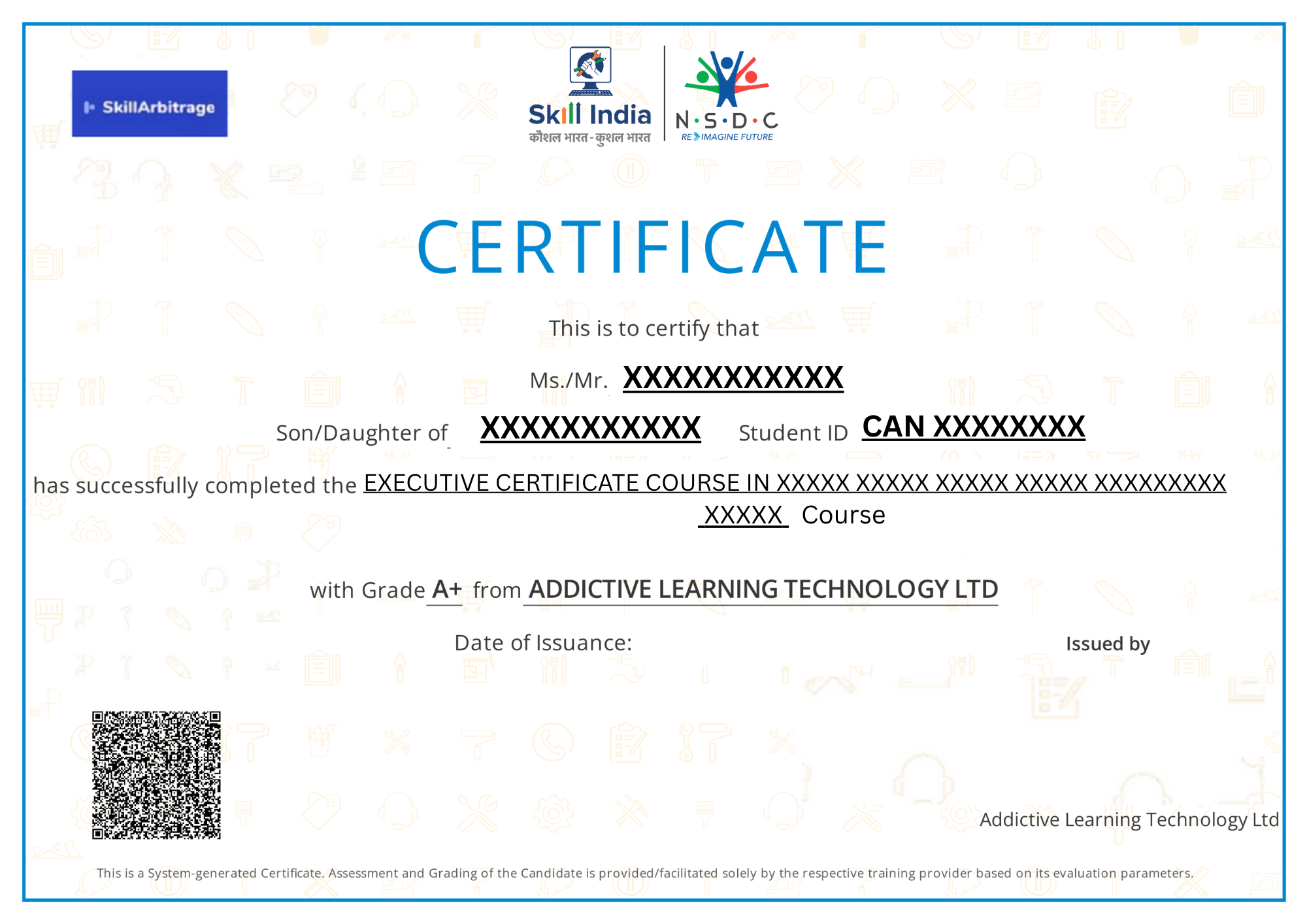 Duration - 6 Month, 8-10 hours/week
Duration - 6 Month, 8-10 hours/week
 Course fee: - INR 63000
Course fee: - INR 63000

This course is recognized by the National Skill Development Corporation, a PPP under the Ministry of Skill Development and Entrepreneurship of the Government of India. You will receive a certificate cobranded by NSDC and Skill India on successful completion.
Key Highlights

Accessible to All: No technical background needed; the course caters to various skill levels.

Expert-Led Training: Learn from experienced professionals who bring real-world insights.

Freelance Support: Gain insights into freelancing, including how to succeed in the market.

Career Assistance: Get help with job searching, resume crafting, and interview prep.

Case Studies: Tackle real-life case studies to bridge theory with practical application.

Weekly Assignments: Engage in regular assignments to deepen understanding and skills.

Doubt Resolution: Benefit from ongoing support to address questions and clarify doubts.
Who should take this course?
- Finance Students & Graduates: No advanced degree needed to pursue careers in corporate finance or investment banking.
- Career Advancers: For those in low-paying jobs aiming for higher salaries in finance.
- Certified Professionals: Ideal for CAs, CMAs, and CSs targeting roles in investment banking and corporate finance.
- Remote Job Seekers: Great for those seeking lucrative remote finance work with international clients.
Money-back guarantee
If you take this course, follow it diligently for a month, do all the exercises but still do not find value in it, or not able to understand or follow it or not find it good for any reason, we will refund the entire course fee to you. It is a 100% money-back guarantee with only one condition, you must pursue it properly for a month. If you don’t find it valuable after that, get your entire money back.
Training Methodology

Live Online Classes
Interactive sessions with screen sharing and personal feedback.

Flexible Timing
Classes after work hours, mainly Sundays or evenings.

Practical Assignments
Apply learnings with relevant take-home tasks.

Feedback Sessions
Weekly opportunities for feedback and live question support.
Certification
This course is recognized by the National Skill Development Corporation, a PPP under the Ministry of Skill Development and Entrepreneurship of the Government of India. You will receive a certificate cobranded by NSDC and Skill India on successful completion.
This is how the certificate from NSDC and Skill India will look as per the current applicable format (may change as per the approval authorities):

Learning objectives of this course
- Financial Analysis: Master key techniques such as vertical, horizontal, trend, and ratio analysis for assessing company statements.
- IPOs and FPOs: Dive into the mechanics and valuation of public offerings.
- Pitch Creation & Financial Planning: Learn to develop pitch decks and understand comprehensive financial planning across life stages.
- Markets and Derivatives: Explore equity, debt, and derivative markets, including instruments and risk management.
- Mergers & Acquisitions and Capital Budgeting: Gain insights into M&A processes and project evaluation methods like NPV and MIRR.
- Equity Research & Financial Modeling: Acquire skills to analyze stocks, build financial models, and make informed investment decisions.
Who will be your potential employers or clients
- Banking and Financial Services: Financial analysts, investment bankers, loan officers in various financial institutions.
- Corporate and Consulting Finance: Roles in financial management, strategy, and mergers and acquisitions consulting.
- Investment Management and Private Equity: Jobs in asset management, hedge funds, and venture capital for portfolio oversight and deal structuring.
- Real Estate and Healthcare: Financial positions in investment, budgeting, and compliance within real estate and healthcare sectors.
- Government, Nonprofits, and Technology: Financial roles in budget management and strategic planning across public, nonprofit, and tech sectors.
- Manufacturing and Consumer Goods: Positions focused on cost management, pricing, and supply chain financing.
What is unique about this course?
- Expert-Led Case Studies: Tackle finance and investment banking scenarios through case studies conducted by industry experts.
- Professional Insights and Skills: Learn practical strategies and freelance skills directly from seasoned finance professionals.
- Networking and Career Support: Access targeted workshops for resume building and interview preparation, and connect with a network of finance professionals.
- Practical Skill Enhancement: Improve in financial analysis, risk management, and valuation with interactive exercises and real-time feedback.
- Certification Opportunities: Earn industry-recognized certifications to enhance your credibility in the finance sector.
Online Faculty

CA AMIT BAJAJ,
A seasoned finance professional with 23+ years of experience across banking, academia, and corporate consulting. A first-attempt Chartered Accountant, he has worked with leading institutions like ICICI Bank, Axis Bank, Yes Bank, and Saraswat Bank, and has taught at COEP Technological University, D.Y. Patil University, and MNLU. His core strengths include credit risk, financial analysis, internal controls, compliance, and project finance. He currently trains professionals at LawSikho in US GAAP,


Mumuksha,
With degrees in B.Com, LLB, and LLM, and brings over 5 years of experience in finance, taxation, and international taxation. I have worked on complex cases involving companies such as BMW, Coursera, Telstra Singapore, and Telstra India. My work includes financial statement analysis, advisory, compliance, and strategic planning, with a focus on simplifying financial data for decision-making. I’m passionate about mentoring students and professionals entering the finance and legal domain.

Syllabus
Players in corporate finance market and their role 
![]() Accounting firms/Public Accounting Firms
Accounting firms/Public Accounting Firms
![]() Corporations
Corporations
![]() Investment banks
Investment banks
![]() Institutions: MFs, PE, pension funds, VC, Seed/angel funds, etc.
Institutions: MFs, PE, pension funds, VC, Seed/angel funds, etc.
![]() Investors
Investors
![]() Buy-side vs. sell-side players
Buy-side vs. sell-side players
![]() Primary market vs. secondary market
Primary market vs. secondary market
Overview of careers and work in corporate finance 
![]() Accounting Firms
Accounting Firms
Due diligence,
Transaction Advisory,
Valuations
![]() Working at banks
Working at banks
Commercial banking
Investment Banking
Equity Research
Sales & Trading
![]() Working at corporates
Working at corporates
FP&A,
Treasury,
Investor Relations
Corporate Development
![]() Working at institutions
Working at institutions
Private equity
Portfolio Management
Research
Key components of corporate finance and commercial motives 
![]() Capital investment
Capital investment
![]() Capital financing
Capital financing
![]() Dividends and return on capital
Dividends and return on capital
Common types of financing transactions 
![]() IPO, including SME IPO
IPO, including SME IPO
![]() FPO
FPO
![]() Private Placement
Private Placement
![]() Leveraged Buyout
Leveraged Buyout
![]() Divestitures
Divestitures
![]() M&A
M&A
Types of capital investments and valuation techniques and terminology 
![]() Time value of money
Time value of money
![]() Net Present Value and how to calculate it
Net Present Value and how to calculate it
![]() Internal Rate of Return and how to calculate it
Internal Rate of Return and how to calculate it
![]() Terminal value of cash flows
Terminal value of cash flows
![]() Exit multiple method
Exit multiple method
![]() Enterprise value and equity value
Enterprise value and equity value
![]() Payback period
Payback period
![]() Profitability index
Profitability index
![]() Practice assignments
Practice assignments
Steps involved in an M&A transaction 
![]() Difference in the motives of strategic buyers vs. financial buyers
Difference in the motives of strategic buyers vs. financial buyers
![]() Acquisition strategy, Acquisition criteria
Acquisition strategy, Acquisition criteria
![]() Searching for the target, approaching the target
Searching for the target, approaching the target
![]() Data and detailed valuation
Data and detailed valuation
![]() Negotiation
Negotiation
![]() Due diligence
Due diligence
![]() Deal documentation - SSAs, SHAs, and SPAs
Deal documentation - SSAs, SHAs, and SPAs
![]() Financing of the acquisition - equity, debt, combination
Financing of the acquisition - equity, debt, combination
![]() Deal compliance: corporate law, foreign exchange regulations, tax, SEBI regulations, stock exchange norms, etc.
Deal compliance: corporate law, foreign exchange regulations, tax, SEBI regulations, stock exchange norms, etc.
![]() Deal closing
Deal closing
![]() Integration
Integration
![]() Competitive bidding in M&A transactions
Competitive bidding in M&A transactions
![]() Hostile vs. friendly M&A
Hostile vs. friendly M&A
Key legal rules around M&A 
![]() Antitrust: How the Competition Act governs M&A procedure
Antitrust: How the Competition Act governs M&A procedure
![]() Rules on Acquisition financing and leverage from banks and NBFCs
Rules on Acquisition financing and leverage from banks and NBFCs
![]() SEBI’s Takeover Code for public company M&A
SEBI’s Takeover Code for public company M&A
![]() RBI’s regulations on how much equity can be held by banks and NBFCs in a company
RBI’s regulations on how much equity can be held by banks and NBFCs in a company
Valuation for M&A 
![]() Criteria for standalone valuation of the target
Criteria for standalone valuation of the target
Sales growth
EBIT margins
Operating tax
Working capital requirements
Capital expenditures
![]() How value synergies are identified
How value synergies are identified
Increase in product mix, improvement in the value chain
Efficiencies of scale in terms of investment and distribution, reduction of overheads
Acquisition of vendor relationships, UP
Tax efficiencies, set-off of tax losses
Exits for private equity 
![]() Total and partial exits
Total and partial exits
![]() Strategic sale
Strategic sale
![]() Private placement
Private placement
![]() Corporate Restructuring
Corporate Restructuring
![]() Basic legal terms and rules to communicate with lawyers
Basic legal terms and rules to communicate with lawyers
Understanding relative priority of debt and equity 
![]() Secured and unsecured debt
Secured and unsecured debt
![]() Senior debt
Senior debt
![]() Subordinated debt
Subordinated debt
![]() Shareholder loans
Shareholder loans
![]() Preference shares
Preference shares
![]() Equity
Equity
![]() What kinds of documentation is needed to create a senior and subordinated debt structure
What kinds of documentation is needed to create a senior and subordinated debt structure
![]() Waterfall in the event of a bankruptcy
Waterfall in the event of a bankruptcy
Equity vs. debt financing 
![]() How to calculate the cost of equity vs. debt
How to calculate the cost of equity vs. debt
![]() Which one is cheaper and what is the optimal structure for a company
Which one is cheaper and what is the optimal structure for a company
![]() Risks of high debt
Risks of high debt
![]() Rate of return in comparison to equity
Rate of return in comparison to equity
![]() Weighted average cost of capital and how it changes
Weighted average cost of capital and how it changes
![]() Typical financial performance metrics and covenants in loan agreements
Typical financial performance metrics and covenants in loan agreements
![]() Corporate funding lifecycle through the different stages of business from launch to maturity
Corporate funding lifecycle through the different stages of business from launch to maturity
Types of debt 
![]() ODs
ODs
![]() Revolving loans
Revolving loans
![]() Term loans
Term loans
![]() Mezzanine debt, equity warrants, debt with warrants, convertible preference shares and debentures
Mezzanine debt, equity warrants, debt with warrants, convertible preference shares and debentures
![]() Best practices to identify how much debt is healthy
Best practices to identify how much debt is healthy
![]() Amount of equity funding, and other ratios
Amount of equity funding, and other ratios
![]() How credit ratings agencies function and grade debt
How credit ratings agencies function and grade debt
Underwriting with respect to public financings 
![]() Hard and soft underwriting
Hard and soft underwriting
![]() Advisory services provided by underwriters
Advisory services provided by underwriters
![]() Book building process and how it works
Book building process and how it works
![]() Roadshows
Roadshows
![]() Pricing of the issue
Pricing of the issue
![]() Full-value and IPO discount
Full-value and IPO discount
![]() Indian legal framework for issue of capital and debt and how it relates to corporate finance
Indian legal framework for issue of capital and debt and how it relates to corporate finance
Understanding dividends/return on capital 
![]() Cost of capital vs. internal rate of return and what that tells us
Cost of capital vs. internal rate of return and what that tells us
![]() What are retained earnings
What are retained earnings
![]() Options to deal with excess cash
Options to deal with excess cash
![]() Buybacks and when they should be undertaken
Buybacks and when they should be undertaken
![]() When to pay cash dividend
When to pay cash dividend
![]() When to reinvest cash
When to reinvest cash
Working capital management for working in corporations 
![]() Accounts receivable management - credit policy, credit analysis, collection management
Accounts receivable management - credit policy, credit analysis, collection management
![]() Inventory management and control, just-in-time inventory management
Inventory management and control, just-in-time inventory management
![]() Accounts payable management, supplier credit, payment terms, cash discounts
Accounts payable management, supplier credit, payment terms, cash discounts
![]() Cash management: Forecasting, cash budgets, cash conversion cycle
Cash management: Forecasting, cash budgets, cash conversion cycle
![]() Short term financing and routes: trade credits, bank loans, commercial paper, etc.
Short term financing and routes: trade credits, bank loans, commercial paper, etc.
![]() Important working capital ratios: current ratio, quick ratio, inventory turnover, and accounts receivable turnover.
Important working capital ratios: current ratio, quick ratio, inventory turnover, and accounts receivable turnover.
Cash flow analysis 
![]() Operating Cash Flow
Operating Cash Flow
![]() Investing Cash flow
Investing Cash flow
![]() Financing cash flow
Financing cash flow
![]() Important cash flow metrics
Important cash flow metrics
Capital Budgeting Process: 
![]() Project identification and screening,
Project identification and screening,
![]() Project evaluation,
Project evaluation,
![]() Project selection, Project implementation,
Project selection, Project implementation,
![]() Project monitoring and control
Project monitoring and control
![]() Risk Analysis: Sensitivity analysis and scenario analysis
Risk Analysis: Sensitivity analysis and scenario analysis
Financial modelling 
![]() How to model financial statements in Excel: income statement, balance sheet and cash flow statement for sales, revenue, expenses or profits
How to model financial statements in Excel: income statement, balance sheet and cash flow statement for sales, revenue, expenses or profits
![]() Important Excel formula for financial modelling work
Important Excel formula for financial modelling work
![]() Formatting spreadsheets
Formatting spreadsheets
![]() Valuation modelling - DCF, comparable company analysis, precedent analysis
Valuation modelling - DCF, comparable company analysis, precedent analysis
Course Plan
Standard
₹ 63000
incl. of all charges
-Printed study material (by courier)
-1 online live class/ week
-2 practical or drafting exercises per week
-Get digital access to entire study material
-Access on LMS, Android & iOS app
-Instructor feedback on assignments
-Unlimited doubt clearing sessions.
-Instructor led course with online live classes
-Online exams (give exams as per your convenience on given time slots)
-Certificate (by courier)
-CV enhancement
-Coaching for professional networking
-Training for writing and publishing articles
-Internship & Job Support
-Interview preparation guidance
-Access to updated content online for 3 years
-Top students are recommended to law firms and companies (as applicable)


 US
US
 IN
IN
 UK
UK





 featured
featured